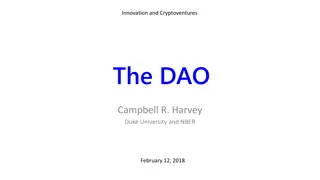
Maersk Cyber Attack: Causes and Resolution
Explore the reasons behind the cyber attack on Maersk, its success factors, resolution efforts, time to recognize the attack, and classification of available information according to cybersecurity standards like NIST.
Download Presentation

Please find below an Image/Link to download the presentation.
The content on the website is provided AS IS for your information and personal use only. It may not be sold, licensed, or shared on other websites without obtaining consent from the author. If you encounter any issues during the download, it is possible that the publisher has removed the file from their server.
You are allowed to download the files provided on this website for personal or commercial use, subject to the condition that they are used lawfully. All files are the property of their respective owners.
The content on the website is provided AS IS for your information and personal use only. It may not be sold, licensed, or shared on other websites without obtaining consent from the author.
E N D
Presentation Transcript
Breakout Group Questions Work together to discuss and answer the following questions
Questions for the Groups 1. Why was Maersk attacked? 2. Why was the attack successful? 3. How was the attack resolved 4. How long did it take to recognize the attack 5. What type of information was available at Maersk and how would you classify it according to NIST CFS, FIBS 199, and NIST 800-53
Why was Maersk attacked? The attack was collateral damage from a state-sponsored cyberwarfare operation primarily targeting Ukraine. The NotPetya malware was initially spread via MeDoc, a Ukrainian tax software widely used by businesses in the country. Although Maersk was not the primary target, its operations in Ukraine meant that its systems were exposed, leading to the rapid spread of the malware across its global network.
Why was the attack successful? 1. Outdated Systems:Maersk s IT infrastructure included old systems such as Windows 2000 and Windows XP, which had known vulnerabilities. 2. Lack of Patch Management: Although Microsoft had released patches to fix the vulnerabilities exploited by NotPetya, Maersk had not updated all of its systems. 3. Supply Chain Compromise: The malware was disguised as a legitimate software update from MeDoc, bypassing traditional security measures. 4. Single-Point Failure Risk: Maersk had 150 domain controllers, but all were online and infected at the same time, leaving no fallback for recovery.
How was the attack resolved? 1. Global IT Rebuild: Maersk had to reinstall 45,000 PCs, 4,000 servers, and 2,500 applications within 10 days a process that would normally take six months. 2. Manual Operations: During the downtime, Maersk reverted to pen-and- paper logistics to keep shipping operations running. Critical Recovery from Ghana: The only surviving domain controller was located in Ghana, where a power outage had kept it offline during the attack. The hard drive was physically transported to London for system restoration
How long did it take to recognize the attack? It took approximately 30 minutes for system administrators to recognize the attack. Full network shutdown took over two hours due to the failure of all communications, including email, messaging, and phone systems.
What type of information was available at Maersk and how would you classify it according to NIST CFS, FIBS 199, and NIST 800-53
Security Architecture Weaknesses Observed Several security architecture gaps contributed to the rapid spread and impact of the attack: Flat Network Topology: Maersk had a highly interconnected IT infrastructure without strong segmentation between business units or critical systems. Lack of Network Segmentation & Access Control: Once the malware entered, it spread horizontally across systems worldwide with minimal barriers. Insufficient Patch Management: Systems remained unpatched despite the existence of a known vulnerability (EternalBlue) exploited by NotPetya. Weak Endpoint Protection: Traditional antivirus solutions were ineffective against NotPetya, which spread using legitimate Windows tools like PsExec and WMIC. Single Point of Failure for Active Directory (AD): All domain controllers were wiped out, meaning no fallback authentication was available. Lack of Immutable Backups: Critical backups were stored online and became encrypted, prolonging recovery.
What do you think is the Board of Directors Responsibility for the Breach The Board of Directors has a fiduciary duty to oversee cyber risk management and ensure that cybersecurity aligns with business continuity. Their potential shortcomings included: Failure to ensure robust cyber risk governance: No enforcement of network segmentation, strong access controls, and critical security patches. Overreliance on outdated IT risk assessments: The Board did not actively challenge IT leadership on resilience planning. Failure to question IT s ability to recover from a major cyber incident: Lack of cyber resilience strategies led to a total collapse of systems.









